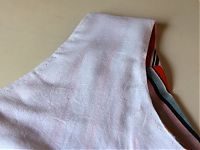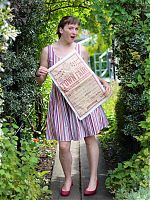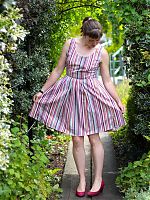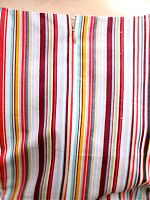In the tech industry, there’s a term “Minimum Viable Product”, which means the absolute minimum you can do to get code out the door. It’s not your best work, but it works.
Like half of London, we had tickets to see Secret Cinema’s performance and screening of the first Back to the Future film, where they recreated the entire 1955 town of Hill Valley, California, complete with about 20 business, the clock tower, full fun fair, a cast of hundreds of actors, you name it. We were also all asked to assume an identity (I was “Tiffany Hyslop, developer!”) and dress in 1955 styles. Now, I’ve only got one 1950s dress pattern (which I made into that Porsche dress a few years back) but it’s too big in the bodice now and would require too much work.
So instead, I picked a modern dress with a 1950s feel – the Simplicity Cynthia Rowley pattern (1873) which I had already made in fuchsia and really liked the fit of.
The pink version was the wrong colour for the 1950s and definitely too short, so I bought some striped cotton poplin from Minerva that had the right vibe, and figured it’d be close enough.
The cotton turned out to be quite narrow, so the incredibly full, pleated back skirt piece didn’t fit on, so I had to take some width out and then just make up the pleats to match the bodice when I was sewing it. The stripes have the ability of disguising pretty much everything though, so even I couldn’t tell if my pleats were even or not.
I managed to cut out the pieces one evening after dinner, but my schedule’s been so jam-packed that I didn’t have a chance to sew it until the day of the performance. Plus I had a two hour trail run to get in first. So in the end, I started sewing at 2pm, and I had to leave at 4:15 to meet James and our friend. So no pressure then!?!
I did a few smart shortcuts in sewing this, and even though I didn’t get to finish the hem before I had to leave, it was definitely good enough for a casual setting, and absolutely better than nothing (or buying something!). So I thought it’d be worthwhile to pass along some of my tips for speed sewing, for when you really, really just have to get it done.
Melissa’s Speed Sewing Tips
- Wherever possible, sew pieces together in a chain, rather than stop to cut your threads after every single piece. Cutting once at the end saves time (and thread).
- If there’s a lining, convert darts to pleats, which are much quicker to sew.
- Pick fabric that doesn’t require print matching.
- Staystitch instead of fuse interfacing wherever possible
- Eliminate pockets or other decorative details (like the half belt on this pattern)
- Sew until you can’t sew any further, then batch press all your sewn seams. It saves time in walking back and forth to the pressing station.
- Sew everything by machine – hand stitching takes too much time! (Knowing how to do an all-machined lining is golden…)
- Consider a machine-stitched hem, or (gasp) keeping it raw

The prick-stitching I added the following day since I skipped understitching to get it done…
For me, my major tradeoffs were that I didn’t have time to understitch the lining to the seam allowances at the neckline and armholes, and that I had a raw hem. To be honest, no one really noticed either at the event, and I was able to go back the next day and sew the hem, then hand prick-stitch the lining while I watched tv.
So even though it was a two hour sew, I’ve ended up with a perfectly nice casual summer dress!















